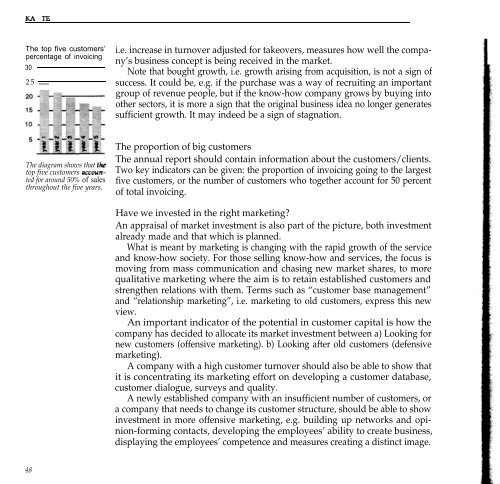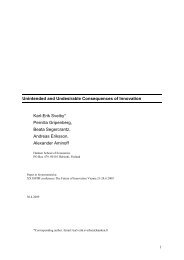Invisible Balance Sheet - Sveiby Knowledge Management
Invisible Balance Sheet - Sveiby Knowledge Management
Invisible Balance Sheet - Sveiby Knowledge Management
You also want an ePaper? Increase the reach of your titles
YUMPU automatically turns print PDFs into web optimized ePapers that Google loves.
The top five customers’<br />
percentage of invoicing<br />
30<br />
25 ,.:.:.:.:.:.<br />
The diagram shows that tk<br />
top five customers accounted<br />
for around 50% of sales<br />
throughout the five years.<br />
48<br />
i.e. increase in turnover adjusted for takeovers, measures how well the company’s<br />
business concept is being received in the market.<br />
Note that bought growth, i.e. growth arising from acquisition, is not a sign of<br />
success. It could be, e.g. if the purchase was a way of recruiting an important<br />
group of revenue people, but if the know-how company grows by buying into<br />
other sectors, it is more a sign that the original business idea no longer generates<br />
sufficient growth. It may indeed be a sign of stagnation.<br />
The proportion of big customers<br />
The annual report should contain information about the customers/clients.<br />
Two key indicators can be given: the proportion of invoicing going to the largest<br />
five customers, or the number of customers who together account for 50 percent<br />
of total invoicing.<br />
Have we invested in the right marketing?<br />
An appraisal of market investment is also part of the picture, both investment<br />
already made and that which is planned.<br />
What is meant by marketing is changing with the rapid growth of the service<br />
and know-how society. For those selling know-how and services, the focus is<br />
moving from mass communication and chasing new market shares, to more<br />
qualitative marketing where the aim is to retain established customers and<br />
strengthen relations with them. Terms such as “customer base management”<br />
and “relationship marketing”, i.e. marketing to old customers, express this new<br />
view.<br />
An important indicator of the potential in customer capital is how the<br />
company has decided to allocate its market investment between a) Looking for<br />
new customers (offensive marketing). b) Looking after old customers (defensive<br />
marketing).<br />
A company with a high customer turnover should also be able to show that<br />
it is concentrating its marketing effort on developing a customer database,<br />
customer dialogue, surveys and quality.<br />
A newly established company with an insufficient number of customers, or<br />
a company that needs to change its customer structure, should be able to show<br />
investment in more offensive marketing, e.g. building up networks and opinion-forming<br />
contacts, developing the employees’ ability to create business,<br />
displaying the employees’ competence and measures creating a distinct image.




